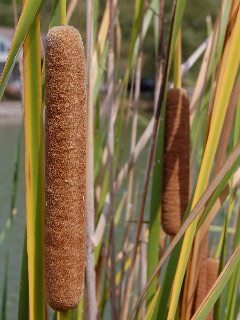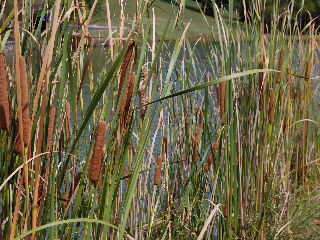
Cattail is the common name for a grouping of plants in the genus Typha.
The cattails are commonly located in swampy marshland areas and around the grassy edges of ponds.
Their unique appearance makes them easy to identify—slender spike about 4 to 6 feet tall with their distinctive flowering seedpod usually very near the top of the stalk.
The male parts of the cattail pod are at the top and the female parts are at the bottom of the same hot dog shaped seedpod.
The brown pod appears very smooth and velvety before the production and dispersion of its seeds—at which time it takes on much the same appearance as a puffy dandelion head about to shed its airborne seeds into the wind.
In addition to regeneration by means of those windborne seeds, the cattail also puts out underground rhizomes that extend and enlarge the domain of the stand of cattails.
Those rhizomes are said to be edible, if one cares to go to the lengths that are necessary in order to harvest them—slogging through the mud and gathering them from beneath the mucky surface.
Also, it is said that the cattail seedpods themselves are edible in the early spring while still in the tender stages of growth by removing the outer covering of the pods and boiling the interior part.
These culinary uses of the cattail plants are said to have been known by the Native Americans who also found practical utility in the softness of the mature seed heads for applications in bedding and in wardrobe construction.
Nature’s greatest purpose for the cattail plants appears to be in the stabilizing of wet areas, thus helping to prevent erosion and in some cases helping to convert the mucky marshland to more firm and stable land areas.

A stand of cattails also provides food and cover for wildlife.
And, to the gardener or lover of the great outdoors, one of the most striking functions of the cattail plants is to contribute still another uniquely beautiful, functional, and unusually picturesque species to add to the remarkable population of plants on earth.
Diversity reigns supreme, and the creativity of Mother Nature never ceases to amaze!
 Cattail is the common name for a grouping of plants in the genus Typha.
Cattail is the common name for a grouping of plants in the genus Typha.
 A stand of cattails also provides food and cover for wildlife.
A stand of cattails also provides food and cover for wildlife.